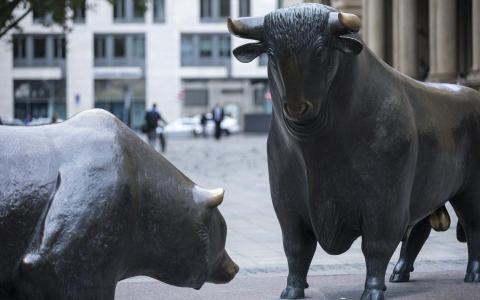
Don't let the term "dramatic changes" scare you like Marley's Ghost. Everyone knows that the big central banks are going to ease off the gas next year. Institutional investors -- the big, mostly long-only money managed by pension funds, university endowments and life insurance firms -- believe it is the end of the world as they know it. But they feel fine.
Institutional money managers are not clamoring to play defense just yet, according to a survey report by Natixis Investment Managers.
The survey was released on Tuesday.
The takeaway from the survey suggests big money investors see more global growth coming, and that will keep them in the market, particularly in the stock market. Though not all stock markets will be treated equally next year.
The consensus is for higher levels of market volatility, greater dispersion of returns, and lower correlations.
Three-quarters of survey respondents said they preferred active management over passive index funds like ETFs.
Last year, around 66% of an institutional investment portfolio was in actively managed strategies.
This year it is 68%, according to Natixis' survey.
Worth noting, institutional investors say they are more willing to look outside of their home countries, which is generally good news for emerging markets. Roughly half (49%) of survey respondents said they will increase their allocations to emerging market stocks, while only 11% said they would increase allocation to U.S. equities.
Emerging market debt was also a favorite with 24% saying they would increase allocation.
European equities had the most bulls, with U.S. having the least amount due to record-breaking gains since March 2009. The U.S. stock market has been on a tear ever since. The survey did not make mention of the potential for corporate tax cuts in the United States and its impact on the sentiment and volume factors.
Natixis interviewed 500 money managers in 31 countries. Some 60% of them said that rate increases in the U.S. will have a negative impact on performance and 75% paid homage to the bears who are rock-solid certain that the Fed, BoJ, and ECB have created asset bubbles worldwide. For them, pain is on the way and possibly next year.
The majority of those surveyed are not as convinced about asset bubbles as the naysayers out there. The market is hopeful that central banks taper their QE injections in the least disruptive way possible. Next year will provide some more clues on how well they manage their slow exit from the market.
Institutional investors may believe bubbles have formed in both the bond (42%) and stock (30%) markets, but concerns for these traditional assets pale in comparison to the 64% who say there’s a bubble in Bitcoins. As if to confirm its bubble status, the currency jumped 11% on November 15, 2017 when digital payment specialist Square Inc. announced it would accept the currency as payment on its mobile system." -- Natixis
Market consensus assumes three rate hikes of 25 basis points in the U.S. in 2018 and for the European Central Bank to continue reducing the size of its balance sheet. The ECB is already reducing by nearly half its monthly purchase of distressed debt and government bonds in general. When rates start rising, many fixed-income investors will take hits on their bonds, especially institutions in Europe that have been mandated to hold zero coupon debt. Who is going to want to buy that? In the past, investors were buying low to no yield bonds because expectations of negative interest rates were realized throughout much of northern Europe. Investors were not buying for yield, they were buying for the capital gains they could get on the bond and could sell them to a willing ECB. Those days are coming to an end. In the best case scenario, this unwinding will be a smooth process with the ECB essentially throwing junk paper into the ether somewhere.
There are positive aspects to this return to normalcy in monetary policy, however, as the central banks will play less of a role in propping up the market.
Leadership change at the Federal Reserve early next year is likely to draw the attention of fund managers trying to read the tea leaves on future interest rate moves. This will lead to volatility early out, particularly in riskier assets south of the border.
The election of President Trump has seen massive liquidity flood into the stock market on expectations of tax cuts, repatriation of corporate cash abroad at low tax rates, and regulatory rollback. Plus, the energy boom that happened under President Obama and stalled out in his last year is now coming back to life. A number of long-term trends are playing out, with at least one having nothing to do with POTUS. The millennial generation is larger than the baby boom generation that saw a four-fold increase in the Dow over the course of around 20 years. The stock market has been rising since the mid-1990s when the youngest boomers were in their 30s.
So far this year, on a weekly basis, the market has pushed into the highest level of overbought conditions on record since 2005, forcing U.S. based institutional investors to look for markets elsewhere, like Europe.
Everyone is waiting for the next big 10% to 20% drop in the stock market, either to pile in at a discount, or to prove themselves correct that the Fed and ECB is behind all this. In technical terms, a return to the critical support levels set at the 2016 low of 1864 in the S&P 500 reached on Feb. 12 would pull roughly 30% off the charts.
"There is some concern that we will move to zero additional liquidity from the central banks by 2019, and the global impact of that will depend on those banks," says Tom Wilson, head of emerging market equities for Schroders, a global asset manager. "We are of the mind that central banks are rational and changes will be made gradually."



